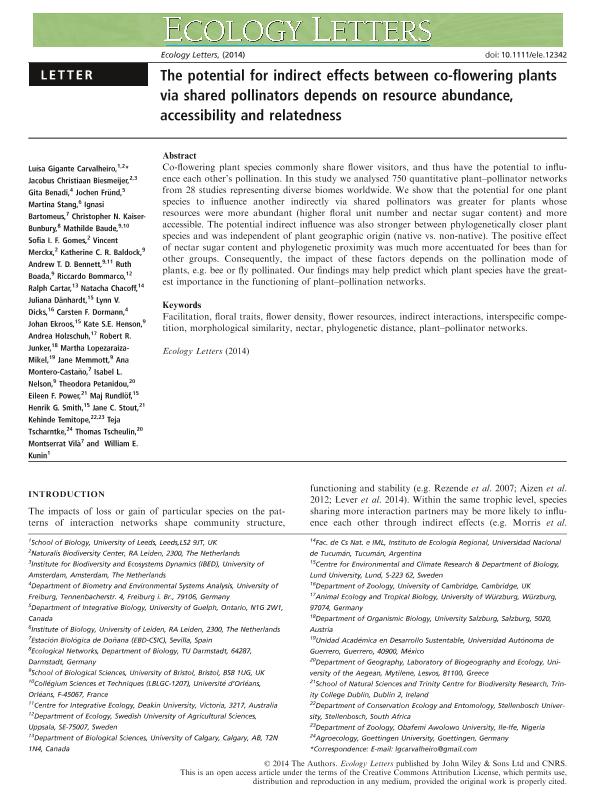Mostrar el registro sencillo del ítem
dc.contributor.author
Chacoff, Natacha Paola

dc.date.available
2016-08-25T14:32:00Z
dc.date.issued
2014-11
dc.identifier.citation
Chacoff, Natacha Paola; The potential for indirect effects between co-flowering plants via shared pollinators depends on resource abundance, accessibility and relatedness; Wiley; Ecology Letters; 17; 11; 11-2014; 1389-1399
dc.identifier.issn
1461-023X
dc.identifier.uri
http://hdl.handle.net/11336/7299
dc.description.abstract
Co-flowering plant species commonly share flower visitors, and thus have the potential to influence each other's pollination. In this study we analysed 750 quantitative plant–pollinator networks from 28 studies representing diverse biomes worldwide. We show that the potential for one plant species to influence another indirectly via shared pollinators was greater for plants whose resources were more abundant (higher floral unit number and nectar sugar content) and more accessible. The potential indirect influence was also stronger between phylogenetically closer plant species and was independent of plant geographic origin (native vs. non-native). The positive effect of nectar sugar content and phylogenetic proximity was much more accentuated for bees than for other groups. Consequently, the impact of these factors depends on the pollination mode of plants, e.g. bee or fly pollinated. Our findings may help predict which plant species have the greatest importance in the functioning of plant–pollination networks.
dc.format
application/pdf
dc.language.iso
eng
dc.publisher
Wiley

dc.rights
info:eu-repo/semantics/openAccess
dc.rights.uri
https://creativecommons.org/licenses/by/2.5/ar/
dc.subject
Facilitation
dc.subject
Floral Traits
dc.subject
Flower Density
dc.subject
Indirect Interactions
dc.subject.classification
Ecología

dc.subject.classification
Ciencias Biológicas

dc.subject.classification
CIENCIAS NATURALES Y EXACTAS

dc.title
The potential for indirect effects between co-flowering plants via shared pollinators depends on resource abundance, accessibility and relatedness
dc.type
info:eu-repo/semantics/article
dc.type
info:ar-repo/semantics/artículo
dc.type
info:eu-repo/semantics/publishedVersion
dc.date.updated
2016-08-17T15:40:00Z
dc.journal.volume
17
dc.journal.number
11
dc.journal.pagination
1389-1399
dc.journal.pais
Reino Unido

dc.journal.ciudad
Londres
dc.description.fil
Fil: Chacoff, Natacha Paola. Universidad Nacional de Tucumán. Facultad de Ciencias Naturales e Instituto Miguel Lillo. Instituto de Ecología Regional; Argentina. Consejo Nacional de Investigaciones Científicas y Técnicas. Centro Científico Tecnológico Tucumán; Argentina
dc.journal.title
Ecology Letters

dc.relation.alternativeid
info:eu-repo/semantics/altIdentifier/url/http://onlinelibrary.wiley.com/doi/10.1111/ele.12342/abstract
dc.relation.alternativeid
info:eu-repo/semantics/altIdentifier/doi/http://dx.doi.org/10.1111/ele.12342
Archivos asociados
